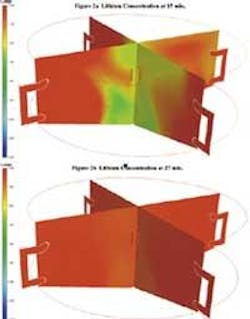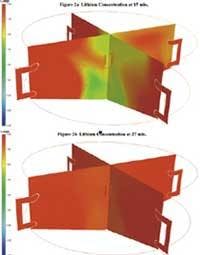CFD Modeling Helps with Digester Mixing System
By Miguel A. Vera and Gerald Mills
Anaerobic digestion is a sludge stabilization process that uses biological processes to degrade complex organic substances in the absence of free or dissolved oxygen. The biological process of anaerobic digestion involves three distinct stages in which the solids present in the sewage sludge are brought in contact with an existing consortium of microorganisms that first hydrolyzes, then ferments and lastly gasifies the original long chain organics and the successive products of each step into stabilized biosolids, methane and carbon dioxide.
The necessity for both an adequate environment for the proliferation of the right types of microorganisms and the required proper contact and interaction of the microorganisms mass with the incoming solids in the raw sewage sludge has generated a need for efficient mixing systems to maximize the yield of the right intermediate products and gas production (CH4).
There are several digestion mixing systems available in the market today and the selection and performance evaluation of them has been of paramount importance for plant operators and consulting engineers. The ASCE/ WEF (1998) established three (3) parameters for evaluating the effectiveness of digester mixer systems:
• Solids Concentration Profile: Adequate mixing is obtained if the solids concentration at any location in the digester does not deviate by more than 10 percent of the average concentration within the digester.
• Temperature Profile: Adequate mixing is obtained if the temperature at any location in the digester does not deviate by more than 2
• Tracer Dispersion Test: Adequate mixing is obtained if the "active volume" is calculated to be at least 90 percent. This method requires addition of a tracer material to the digester followed by sampling and analysis of the tracer over an extended period of time. Analysis of this data generates a resulting active volume percentage.
The above tests can be expensive and time consuming because they require careful sampling, extensive lab work and mathematical analysis to obtain significant results. They can only be used for evaluation of existing digesters and they are of little help while designing a new digester. For this purpose, the design engineer has used several commonly employed design parameters established as recommendations by the ASCE / WEF (1998), such as specific power input, velocity gradient, turnover time and specific gas recirculation rate.
These parameters have provided a somewhat adequate empirical method to design digester mixing systems, but are incapable of accounting for the specific sizes, shapes and geometry of digesters or the specific approaches to applying either mechanical energy or gas recirculation to digesters.
To optimize digester mixing system design in a specific digestion tank, new techniques are needed if anything more than a crude design is expected.
With the development and availability of massive computer processing power and software capable of complex fluid dynamics analyses, EIMCO has taken the lead in the development and application of sophisticated models to take digester mixing system design to the next level. In pioneering the use of "Computational Fluid Dynamics" (CFD) analysis to the design and evaluation of such mixing systems, the company has demonstrated the ability to custom design and optimize mixing systems based on the specific digestion tank being designed.
As part of this development, EIMCO calibrated the application of CFD computer simulation technology to well documented, reliable tracer evaluations performed in operating digestion tanks. For example, the company selected the tracer wash out study performed at the Lower Muddy Creek WWTP in Winston-Salem, NC, reported by Dupont et al (1988), to be recreated using its CFD simulation model.
Lower Muddy Creek has a 100 foot tank with a 1.9 million gallon nominal volume. It was mixed with four external mixers located at each quadrant of the tank and one center mixer. The mixers had a 15,000 gpm pumping capacity each. The field tracer tests were done in two steps, first a complete mixing test in a batch mode for 22 hours and then a long-term tracer wash out for 90 days. The batch test showed a complete mixed tank at the sample points within 15 minutes of the tracer slug addition, while the wash out test analyzed using the methods of Wolf and Resnick (1963) and Monteith and Stephenson (1981), showed an average active volume of 94.65 percent.
A critical step in the development and calibration of CFD simulation to digestion mixing systems required the construction of a CFD simulation model for each actual installed system such as that for the Lower Muddy Creek WWTP digestion tank/mixing system. After the 3D model of the tank and mixing system was generated (using a mesh of 400 K+ elements), a tracer concentration dispersion prediction was simulated by using a transient condition within the tank contents. A measurable generic scalar variable was used to represent the volume fraction of a lithium chloride solution as it was mixed into the tank. A scalar value of 1.0 (which represents 100 percent LiCl solution) was applied to the tank contents. Turbulence was replicated using a constant eddy viscosity model along with individual mixer pumping rates for the units installed at the Lower Muddy Creek plant.
Results of the CFD transient analysis simulating the tracer dispersion were recorded every three minutes. The tracer was predicted to be well mixed and to arrive at the initial theoretical lithium concentration of 2.09 mg/L used during the field test at the end of 15 minutes.
At 15 minutes it was apparent there were zones that had not reached complete mixing, however the sampling points used in the field are at points where good mixing had been achieved. By mixing the tank contents to the normal target of 30 minutes turnover time, the mean concentration reaches a steady level 2.00 mg/L at 27 min.
The calibrated, computational fluid dynamics design model predicted lithium concentration levels that closely mirror the conditions described on the Lower Muddy Creek field study.
In conclusion, EIMCO engineers have successfully designed and calibrated a CFD model to predict mixing characteristics found in actual digester installations based on field tracer tests. This design tool provides significantly more opportunity to evaluate alternative mixer design scenarios during the design stage to insure that optimum performance at least cost is achieved.
About the Authors:
Miguel Vera is a MS in Civil Engineering candidate at the University of Utah and is the Product Marketing Engineer of Anaerobic Digestion products at EIMCO.
Gerald Mills, PE, has a bachelors degree in Mechanical Engineering from the University of Utah. He has been working in the field of process equipment design for nine years and has helped pioneer the CFD work at EIMCO.

